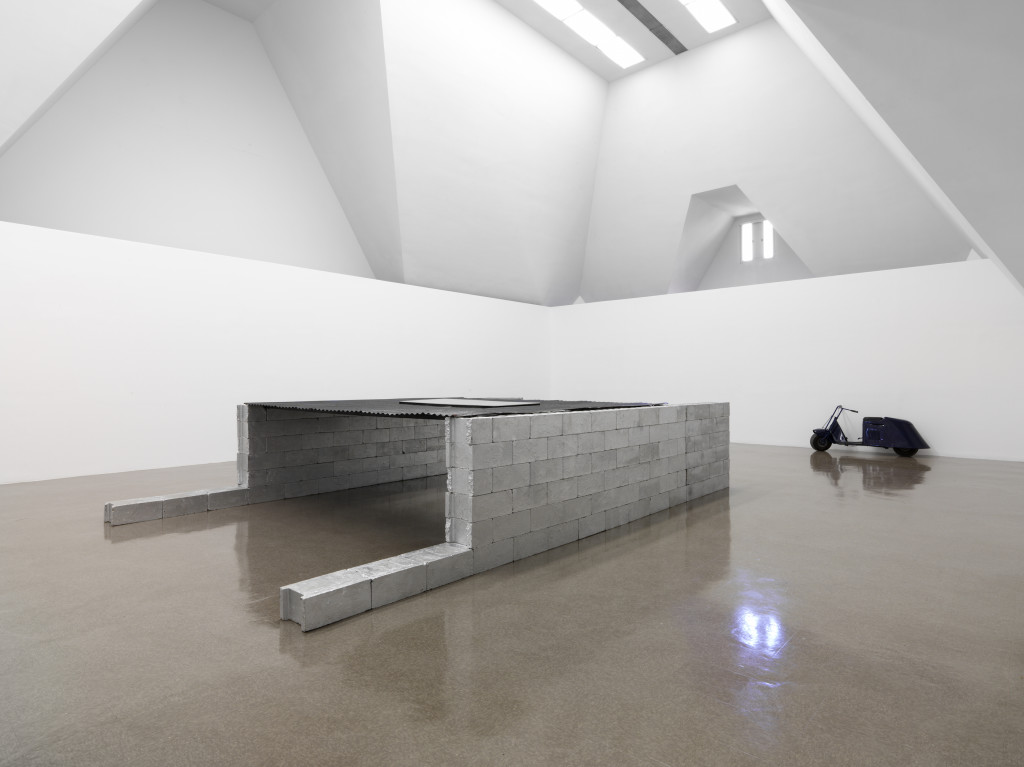Robert Gosvenor: The Renaissance Society
by Caroline Picard
Instead of counting sheep at night, I imagine the floor plans of places I’ve lived in an attempt to match scale, function, space, and memory. Invariably I discover blind spots—an impossible void in the middle of an apartment for instance, or the ambiguous depth of a closet—the puzzle of these projected architectures puts me to sleep. In dreaming, I appear similarly preoccupied by the details of space, for though I’m usually unable to recall the expression of a friend’s face, my waking-self will return to the incoherence of a given dream-room: how a bathtub sat in the middle of a kitchen that simultaneously conducted itself as an indoor corridor and an outdoor bridge. Perhaps it is strange to reference the nebulous expanse of dream life in a review of Robert Grosvenor’s recent Renaissance Society exhibition, but I was encouraged when I came across the artist’s 1968 statement, “I like things I’ve seen very fast and I don’t remember what they are; but I remember the outline, the image. I’d like my sculptures to be remembered the same way.”1
It is not simply that Grosvenor’s sculptures succeed in making the discrepancies of memory and reason concrete, but that his 2017 installation of Untitled 1989-1990 fulfills it so completely, both according to the work’s unique comportment and the properties of its context. The sculpture is comprised of two long rows of cinder blocks supporting a corrugated tin roof with a plexiglass skylight. A vintage scooter leans against a nearby wall; it is finished in the same matt blue as the (albeit more weathered) corrugated tin ceiling. Freshly built walls snuggle around the installation on the fourth floor of a university in Chicago’s South Side and everything about the room feels settled, as though its parts have been waiting to be put to use for some time. And yet part of encountering Untitled 1989-1990 in this particular venue is remembering the rickety elevators upon which one traveled to get to the gallery; these well-used, utilitarian boxes seem vulnerable and frail in comparison to the weight of Grosvenor’s cinderblocks. As though by moving up and down on a vertical plane multiple times each day, they reflect a strange anxiety in comparison to the horizontal, and perhaps also useless sprawl of Untitled 1989-1990. Afterall, this work doesn’t even have a name to offer but rather a span of a single year in the almost distant past. Could it have been carried up the same elevator? So, the immediate experience of Untitled 1989-1990 brings me back to that state just before sleep, where I work over logistical and architectural reconciliation.

But beyond the site-specific practicalities of the installation, one is similarly met by the curious structure of Grosvenor’s sculpture. As in a dream, the object’s composition bears authority, riffing off the vernacular material of cinder blocks and corrugated tin. Were it to appear outdoors—perhaps viewed from a train in someone’s backyard—the work would disappear into the landscape, innocuous as any shed. But here, the sculpture’s formal composition resists practical application, withholding the use-value its materials were fabricated to fulfill. The cinder blocks themselves are covered in metallic silver paint—is this decorative or does the silver sheen come from some weathering protectant? Both walls of blocks extend on one side into skinny feet, as though the project of building these walls was partially abandoned. Meanwhile, the corrugated roof covers only one half of the structure. Why wouldn’t it entirely bridge the gap between both walls? Suddenly the settled aura of these materials admits inherent doubt, revealing either a secret purpose to which all aspects of its design conspire or an ambivalence for its own project. Lastly, the plexiglass ceiling in the tin roof belies functionality, and yet the entire structure is no taller than my hip. Who would need to crawl under there and hang out long enough to want light? The skylight is also functionally redundant. Given that the shelter’s two sides are open to the air, it admits plenty of light without needing any windows. Why then was this feature added? Here again I bump into the feeling just before sleep, where I am unable to make sense. In his talk about show, poet and critic John Yau said, “Grosvenor’s structure is apt to remind you of something you have seen in your life…It all feels purposeful and necessary, but at the same time mysterious.”2
There is something joyful about discovering uncertainty in his shelter, for if it is here might it not exist everywhere, in all of the architectures one takes for granted each day? The vulnerability of our elevator comes to mind again, inviting interrogation. There is room to doubt and puzzle and intervene, challenging the authority of seemingly ancient institutions and skyscrapers the break the horizon. So the scooter comes to mind again: referred to as “adjunct” by the artist, it has never allegedly been shown with the piece before now. And, in a way, it rests here like the performance of an afterthought: boasting the triumph of agile movement—you can almost imagine the ease with which the vehicle could loop around the gallery—poised in stark contrast to the heavy, rectilinear form of its untitled relation. I at least identify with this object; it could almost fit under the shelter and its mobility suggests somehow that it occupies a different time frame, like something less permanent than the cinder blocks it communes with. While it’s true that Grosvenor’s work teases the viewer with a kind of mystery, it nevertheless reveals the building blocks we take for granted in daily life, unearthing their form to show an almost linguistic diagram of conscious thought.
Robert Grosvenor ran at the Renaissance Society from February 11, 2017 to April 9, 2017.